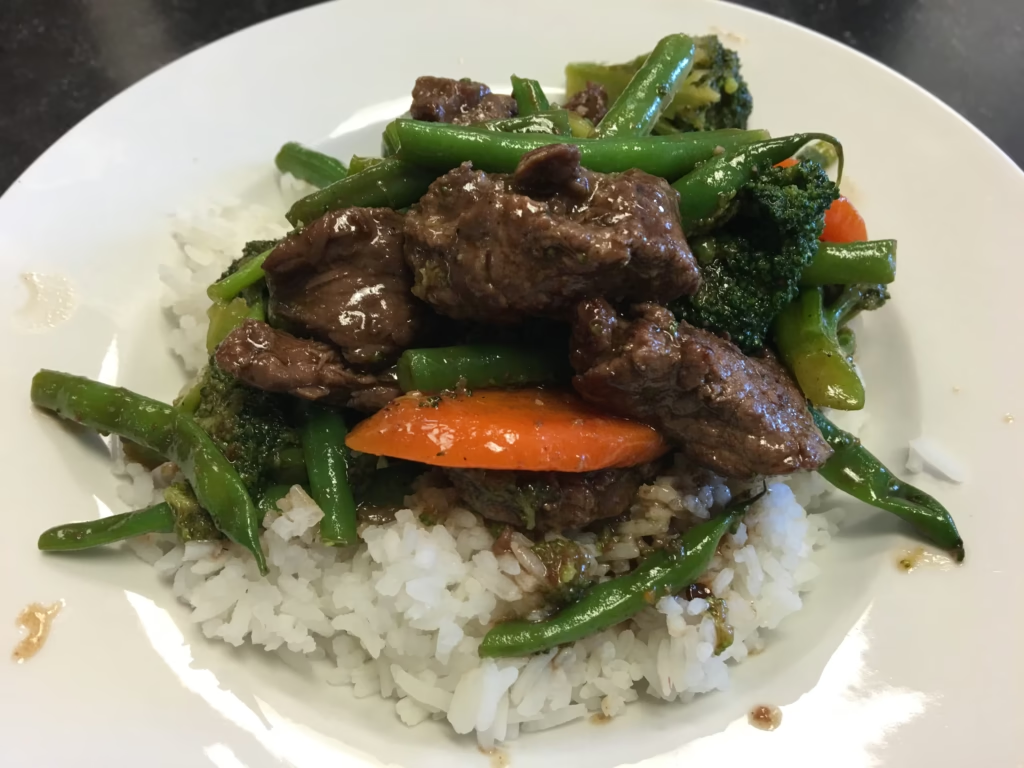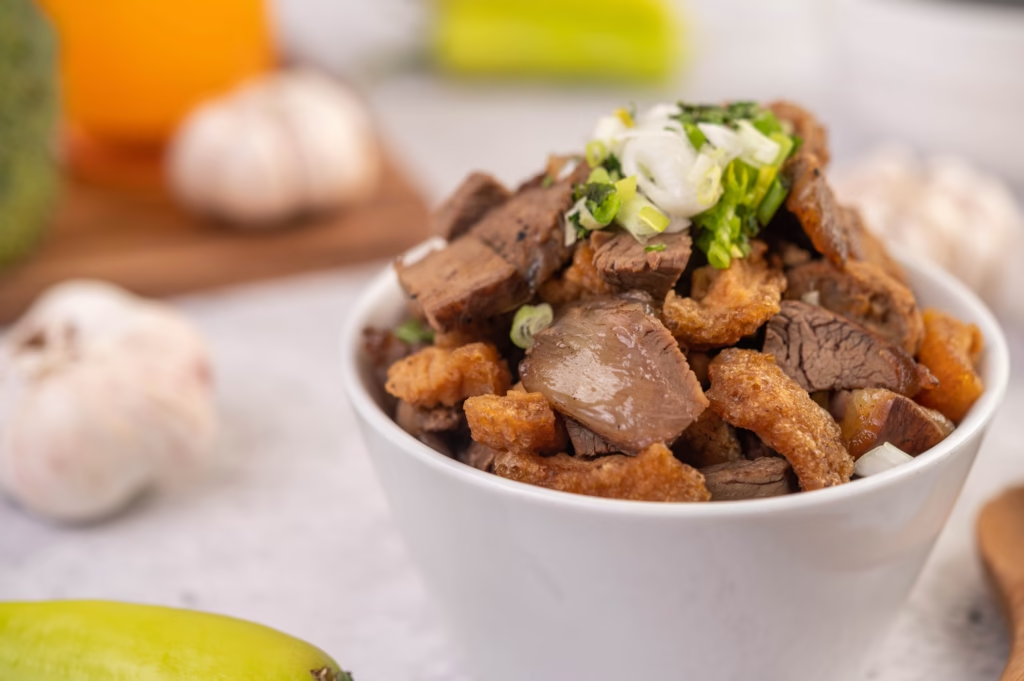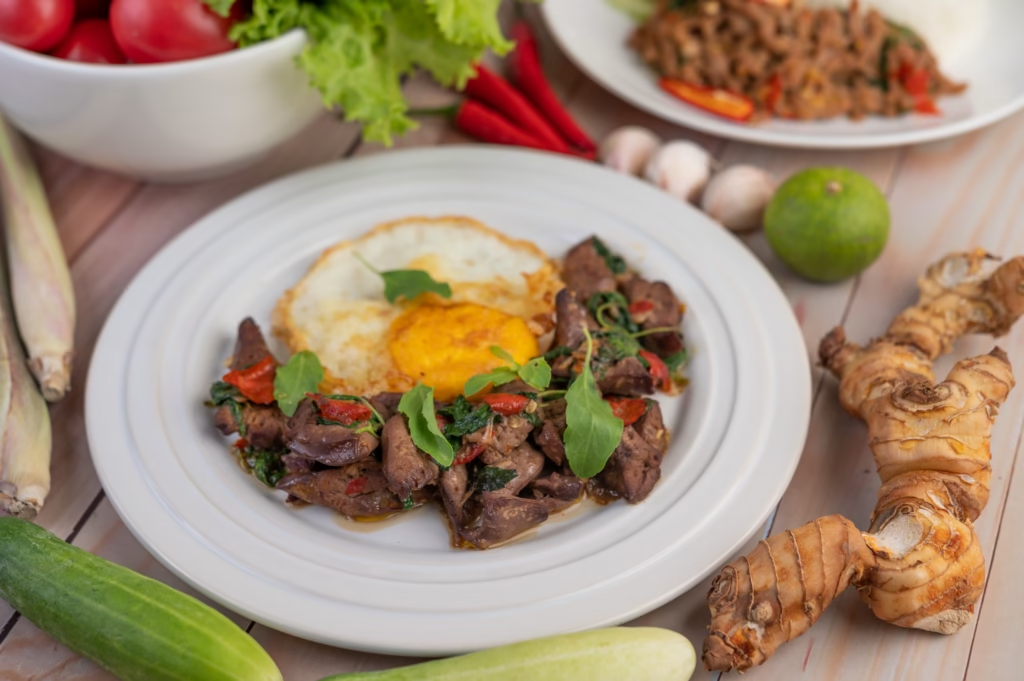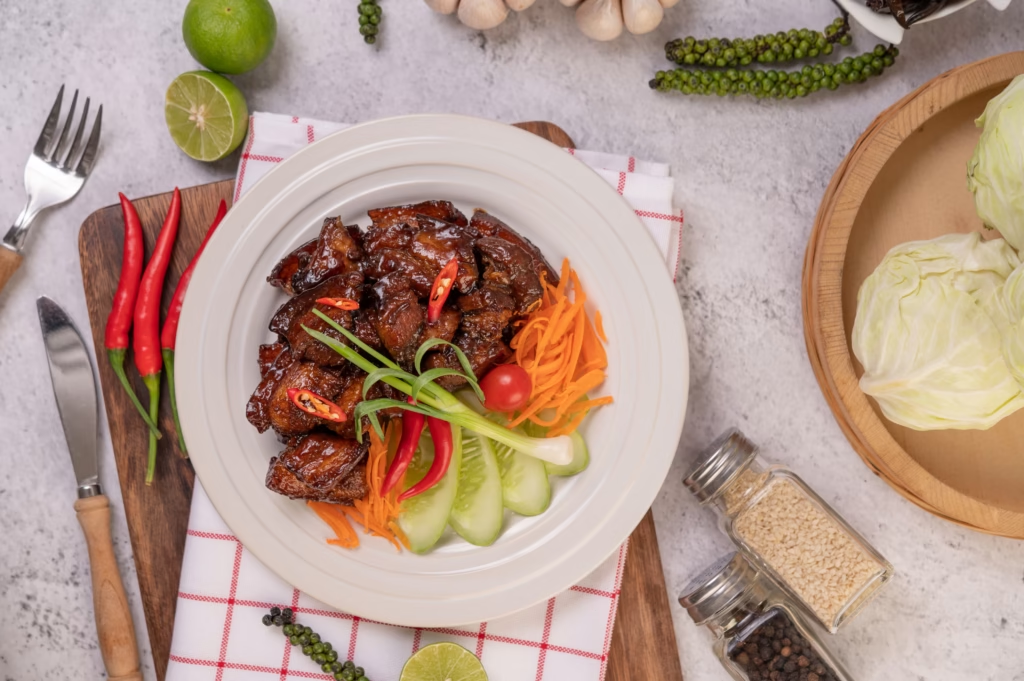Stir-fries are a beloved meal option for their speed, versatility, and satisfying flavors. If you’re someone who craves a delicious yet simple dish that can be prepared in less than 30 minutes, easy beef stir-fry is your go-to recipe. Whether you’re a seasoned cook or a beginner in the kitchen, this dish can be whipped up effortlessly, giving you a hearty, flavorful meal that’s perfect for any time of day.
In this article, we’ll walk you through everything you need to know about making the perfect easy beef stir-fry, from selecting the right ingredients to tips on achieving the perfect texture and flavor. Let’s dive in!
Introduction to Easy Beef Stir-Fry
Beef stir-fry is one of those dishes that never fails to satisfy. It’s quick, it’s flavorful, and it’s incredibly versatile. Whether you’re in the mood for something spicy or savory, this dish can easily be adjusted to your personal taste. For anyone new to stir-frying, don’t worry! This recipe is designed to be super simple, allowing you to master the technique in no time.
In addition to being a quick go-to meal, stir-fries are also a great way to use up whatever vegetables and meat you have in your fridge. With a few simple ingredients, you can create an impressive dish that’s both nutritious and delicious. And if you’re looking for a dessert to complement your meal, why not try an Easy Strawberry Shortcake Cake Recipe – Quick & Delicious Guide? It’s a simple and delightful treat to balance the savory goodness of the stir-fry!
Essential Ingredients for Easy Beef Stir-Fry

Choosing the Right Cut of Beef
The key to a successful easy beef stir-fry lies in the beef itself. Since stir-frying is a quick cooking method, it’s crucial to pick a cut that cooks fast and remains tender. For the best results, opt for cuts like flank steak, sirloin, or rib-eye. These cuts are known for their tenderness and ability to absorb the flavors of the sauce.
- Flank steak: This cut is affordable, flavorful, and easy to slice thinly, making it ideal for stir-fries. Be sure to slice it against the grain to ensure tenderness.
- Sirloin: A leaner cut, sirloin is slightly tougher but still works wonderfully for stir-fries, especially if sliced thinly.
- Rib-eye: Known for its marbling, rib-eye offers a richer flavor but tends to be pricier. It’s excellent for a special stir-fry.
Whichever cut you choose, make sure to slice the beef thinly, about 1/8 inch thick, as this allows the meat to cook quickly and evenly.
Fresh Vegetables for Crunch and Flavor
A stir-fry isn’t complete without the addition of fresh vegetables. These vegetables add texture, color, and a nutritional punch to your easy beef stir-fry. Here’s a list of popular vegetables used in stir-fry dishes:
- Bell peppers: Colorful and slightly sweet, bell peppers bring a nice crunch to the dish.
- Broccoli: Packed with fiber and vitamin C, broccoli adds a crunchy texture and pairs well with the beef.
- Carrots: Thinly sliced or julienned carrots add sweetness and color to the stir-fry.
- Snow peas: Their subtle sweetness and crisp texture make them an excellent addition.
- Onions: Sliced onions provide an aromatic depth and complement the beef flavor.
Feel free to experiment with other vegetables like zucchini, baby corn, or mushrooms. Stir-fries are versatile, and you can mix and match vegetables based on what’s in season or what you prefer.
The Stir-Fry Sauce: Balancing Flavors
The sauce is what ties everything together in an easy beef stir-fry. A good stir-fry sauce should balance salty, savory, sweet, and acidic flavors to enhance the beef and vegetables. Here’s a basic stir-fry sauce recipe:
- Soy sauce: The base of most stir-fry sauces, soy sauce adds a salty, umami depth.
- Oyster sauce: This gives a slightly sweet and earthy flavor.
- Hoisin sauce: For a hint of sweetness and a touch of spice.
- Ginger and garlic: Freshly minced ginger and garlic are the aromatic foundations of the sauce.
- Rice vinegar or lime juice: This adds acidity and freshness to balance the richness of the soy and hoisin sauces.
- Cornstarch: A small amount of cornstarch mixed with water helps thicken the sauce and create a glossy finish.
Feel free to tweak this sauce by adding some chili flakes or chili paste if you like heat. For a lighter version, you can use low-sodium soy sauce and skip the oyster sauce.
Oil for Stir-Frying
The type of oil you use for stir-frying is also crucial. You’ll want an oil with a high smoke point, which will allow you to cook at high heat without burning. Common oils used for stir-frying include:
- Canola oil: A neutral oil that’s perfect for high-heat cooking.
- Peanut oil: Known for its high smoke point and slight nutty flavor, peanut oil is commonly used in stir-frying.
- Sesame oil: While often used as a finishing oil for flavor, toasted sesame oil can also be used in small quantities for stir-frying to add depth to the dish.
Optional Ingredients
To take your easy beef stir-fry to the next level, consider adding:
- Sesame seeds: Toasted sesame seeds can be sprinkled on top for added texture and flavor.
- Green onions: Sliced green onions add a fresh, mild onion flavor.
- Chili paste: If you like your stir-fry with a bit of heat, a spoonful of chili paste can elevate the dish.
If you have more time, you can even try Quick and Easy Lasagna for another comfort food option that’s just as quick and delicious.
Step-by-Step Instructions for Easy Beef Stir-Fry

Step 1: Prepare the Ingredients
Start by prepping your ingredients. Thinly slice your beef against the grain to ensure tenderness. Next, chop your vegetables into bite-sized pieces. Bell peppers, onions, and broccoli work beautifully in a stir-fry, but feel free to mix it up with other veggies like snap peas or mushrooms.
Step 2: Make the Stir-Fry Sauce
In a bowl, combine soy sauce, cornstarch, sesame oil, ginger, and garlic. Stir until the cornstarch dissolves completely. This mixture will form the base of your stir-fry sauce. For a touch of sweetness, you can add a teaspoon of honey or brown sugar. If you’re looking for more recipes, consider trying a Strawberry Shortcake Recipe – A Sweet and Simple Guide for a perfect dessert after your savory stir-fry.
Step 3: Cook the Beef
Heat a large skillet or wok over medium-high heat. Add a tablespoon of sesame oil and let it heat up. Add the beef slices and cook until browned and cooked through, about 3-4 minutes. Once done, remove the beef from the skillet and set it aside.
Step 4: Stir-Fry the Vegetables
In the same skillet, add another tablespoon of sesame oil. Toss in your chopped vegetables and stir-fry for about 4-5 minutes, or until they’re just tender but still crisp. The idea here is to retain their color and crunch.
Step 5: Combine Everything
Add the cooked beef back into the skillet, followed by the stir-fry sauce. Toss everything together until the beef and vegetables are coated evenly in the sauce. Cook for another 2-3 minutes to allow the sauce to thicken. Serve the stir-fry over rice or noodles, and enjoy the flavors.
Cooking the Beef Stir-Fry

Step 1: Heating the Wok or Skillet
The key to a great stir-fry is high heat. Begin by heating your wok or large skillet over medium-high heat for about 2-3 minutes. You want the pan to be very hot, but not smoking, so it can sear the ingredients quickly. This searing is what locks in flavor, giving your beef that perfectly caramelized texture.
Once the pan is hot, add 1 tablespoon of oil. Ideally, use a high-heat oil like vegetable oil, canola oil, or peanut oil. These oils can withstand the heat without burning, ensuring that your stir-fry cooks evenly.
Step 2: Stir-Frying the Beef
Once your oil is hot, it’s time to add the marinated beef. Carefully add the beef in a single layer, and don’t overcrowd the pan. If necessary, cook the beef in batches to ensure it sears properly. Stir the beef continuously with a wooden spoon or spatula to ensure it cooks evenly. The beef should only take 2-3 minutes to cook through, becoming tender and browned on the outside.
A key tip here is not to overcook the beef. Since it’s sliced thin, it cooks very quickly. Once the beef has browned and is no longer pink, remove it from the pan and set it aside on a plate. This ensures the beef remains juicy and doesn’t become tough.
Step 3: Stir-Frying the Vegetables
In the same pan, add another tablespoon of oil. If there’s any leftover marinade or juices from the beef, that’s okay — it will only add more flavor to the stir-fry. Toss in the vegetables in order of their cook time. Start with harder vegetables like carrots and broccoli, as they take a little longer to cook. Stir-fry them for about 2-3 minutes, allowing them to soften slightly but still retain some crunch.
After a few minutes, add the remaining vegetables: bell peppers, snow peas, and onions. These vegetables only need about 2 minutes of stir-frying, so they retain their crisp texture and vibrant color. Keep stirring frequently to ensure everything cooks evenly and nothing sticks to the pan.
Step 4: Combining the Beef and Vegetables
Once the vegetables are cooked to your liking, it’s time to bring everything together. Return the cooked beef to the pan, along with any juices from the plate. Give everything a good toss to mix the beef and vegetables together.
Now it’s time for the stir-fry sauce. Pour the sauce evenly over the beef and vegetables, and stir everything together to coat it in the sauce. You’ll notice the sauce will thicken up quickly due to the cornstarch. Allow the stir-fry to cook for another 2-3 minutes, making sure the beef is heated through and the sauce has had time to meld with the vegetables.
Step 5: Final Touches
Once everything is coated with the sauce and the beef is reheated, taste and adjust the seasoning if needed. If you like a spicier stir-fry, add a dash of chili flakes or a few drops of hot sauce. You can also garnish with a sprinkling of sesame seeds or sliced green onions for extra flavor and texture.
At this point, your easy beef stir-fry should be ready to serve! Pair it with steamed rice, noodles, or even quinoa for a complete meal.
In the next part, we’ll cover some easy variations and tips to personalize your beef stir-fry, plus ideas for making this dish your own. Ready to make it even better? Let’s dive in!
Variations and Customizing Your Easy Beef Stir-Fry

1. Add More Vegetables for Extra Flavor
One of the best things about stir-fry is how versatile it is. You can easily customize your stir-fry by adding different vegetables based on what you have in your kitchen. For example, bok choy, mushrooms, baby corn, zucchini, or spinach are fantastic additions to your stir-fry.
- Bok Choy adds a mild, slightly peppery flavor and pairs beautifully with beef.
- Mushrooms bring an earthy richness that balances the savory beef.
- Baby corn offers a sweet crunch, adding texture to your stir-fry.
The beauty of a stir-fry is that you can load it with as many or as few vegetables as you like. If you’re looking to make the dish healthier, increasing the vegetable-to-meat ratio is a simple way to do so.
2. Switch Up the Protein
While beef is the star of this stir-fry, you can also switch up the protein to create a new flavor experience.
- Chicken breast or chicken thighs work just as well as beef, and they absorb flavors beautifully.
- Shrimp can be a great alternative if you’re craving seafood. They cook quickly and pair excellently with the stir-fry sauce.
- Tofu is a great plant-based option if you’re looking for a vegetarian or vegan alternative. Make sure to press the tofu to remove excess moisture before adding it to the stir-fry, so it can soak up the flavor of the sauce.
By swapping out proteins, you can enjoy a completely new stir-fry dish each time while keeping the rest of the ingredients the same.
3. Adjust the Sauce for Your Tastes
The stir-fry sauce is key to the dish’s flavor. However, you can easily tweak the sauce to suit your personal preferences or dietary needs. Here are a few ways to adjust the sauce:
- Less sugar: If you’re cutting down on sugar, simply reduce or omit the brown sugar or honey. You can substitute it with stevia or another natural sweetener if you prefer.
- Add more heat: If you like a spicier kick, add more chili flakes, sriracha, or a dash of hot sauce.
- Soy-free: If you’re sensitive to soy, substitute coconut aminos or tamari (which is gluten-free) instead of regular soy sauce.
- Add ginger: Fresh ginger adds a warm, aromatic depth to the sauce. If you want a zesty edge, grate a bit of ginger directly into the sauce mixture before adding it to the stir-fry.
The sauce is customizable and can be adjusted to fit almost any dietary restriction or personal taste.
4. Make It Gluten-Free
If you’re following a gluten-free diet, you don’t have to miss out on stir-fry! You can easily make your stir-fry gluten-free by swapping regular soy sauce for gluten-free tamari or coconut aminos. Just make sure all the other ingredients (like your stir-fry noodles or rice) are gluten-free as well.
Another option is to use rice noodles or zucchini noodles (zoodles) as a base, instead of traditional wheat-based noodles. These swaps won’t compromise on flavor and will help keep your stir-fry completely gluten-free.
5. Make It Spicy!
If you love spice, adding a little heat can elevate your easy beef stir-fry. Consider using:
- Chili garlic sauce: For a spicy and garlicky kick, you can stir in some chili garlic sauce. It will blend beautifully with the stir-fry sauce.
- Fresh chilies: Slice up some jalapeños, bird’s eye chilies, or serrano peppers and toss them in with the vegetables. This will give your stir-fry an extra spicy punch.
- Crushed red pepper flakes: If you want to control the level of spice, red pepper flakes are a great addition that can be sprinkled on top at the end.
Spice lovers will enjoy the bold and fiery kick these options bring to the dish.
6. Add Sweetness with Pineapple
For a sweet and savory combination, try adding pineapple chunks to your stir-fry. The sweetness of pineapple balances out the salty soy sauce and adds a refreshing burst of flavor. Pineapple also provides a juicy texture that contrasts nicely with the beef and vegetables.
7. Make It Low-Carb
If you’re following a low-carb or Keto diet, you can still enjoy this stir-fry without the carbs. Here are a few alternatives:
- Instead of regular rice, serve your stir-fry over cauliflower rice for a low-carb substitute. You can make cauliflower rice easily by grating cauliflower florets and sautéing them in a pan.
- Skip the noodles altogether, or use shirataki noodles (also known as miracle noodles), which are made from konjac yam and have almost no calories or carbs.
These swaps keep the stir-fry tasty and satisfying while keeping your carb count low.
8. Add Nuts for Extra Crunch
To add extra texture to your stir-fry, throw in some cashews, peanuts, or almonds just before serving. The nuts add a delightful crunch that complements the tender beef and crisp vegetables. Plus, they introduce a new flavor dimension that makes the dish even more satisfying.
In the next section, we’ll explore how to serve your easy beef stir-fry with different side dishes, giving you even more options for creating a complete, mouthwatering meal.
Serving Your Easy Beef Stir-Fry

1. Serve with Steamed Rice
One of the most classic and satisfying ways to serve your easy beef stir-fry is over a bed of hot, steamed rice. The fluffy, neutral flavor of white rice complements the savory, flavorful stir-fry sauce perfectly. It helps balance out the intensity of the dish and makes each bite satisfying.
For a healthier twist, you can opt for brown rice. It offers more fiber, nutrients, and a heartier texture. If you want to make it even more interesting, try jasmine rice for a fragrant, aromatic touch, or basmati rice for a slightly nuttier flavor.
2. Pair with Noodles
If you’re craving noodles, easy beef stir-fry can be paired with any kind of stir-fry noodles, from egg noodles to rice noodles. Thin egg noodles absorb the sauce beautifully and create a lovely contrast with the beef and vegetables. For a gluten-free option, rice noodles or soba noodles (which are made from buckwheat) can be a great choice.
To make it more filling, you can toss your noodles with a bit of the stir-fry sauce before serving to ensure they soak up the flavor and complement the beef and vegetables.
3. Serve with Stir-Fried Vegetables
While your easy beef stir-fry already contains vegetables, you can serve it alongside extra stir-fried vegetables for even more variety and color. Stir-fried broccoli, snow peas, carrots, and bell peppers work wonderfully with this dish.
The extra veggies add more texture and flavor, giving your meal more balance. You can also toss a handful of spinach or arugula into the pan right at the end, letting the heat from the stir-fry slightly wilt the greens for added color and nutrients.
4. A Side of Crispy Spring Rolls
If you want to take your easy beef stir-fry to the next level, consider serving it with a side of crispy spring rolls. The crunchy, golden exterior and flavorful filling of these rolls pair wonderfully with the savory stir-fry. You can opt for traditional vegetable spring rolls or shrimp spring rolls, depending on your preference.
To make it even easier, buy pre-made spring rolls from the store or make them at home. Simply roll up a mix of veggies and protein in rice paper, and fry them up until golden and crispy.
5. Top with Fresh Herbs
While your stir-fry has plenty of flavors, adding some fresh herbs can really elevate the dish. Top your stir-fry with a handful of cilantro or green onions to bring brightness and a fresh herbal note. The contrast between the warm, savory stir-fry and the cool, fresh herbs adds a level of complexity to the dish that is truly irresistible.
Additionally, you could garnish with a squeeze of lime juice for a refreshing, tangy finish. The acidity from the lime balances out the richness of the sauce and adds another layer of flavor to your dish.
6. Make it a Wrap
If you’re in the mood for something different, you can transform your easy beef stir-fry into a delicious wrap. Take some lettuce leaves (like romaine or butter lettuce) and use them as wraps. Spoon the stir-fry into the center and fold the edges of the lettuce to make a quick, low-carb, and fresh meal.
You can also use whole wheat tortillas or rice paper wraps to give your stir-fry a unique twist, making it more portable and easy to eat on the go. This is a perfect option for meal prep or a healthy lunch.
7. Serve with Kimchi or Pickles
For a more authentic Asian flavor, pair your stir-fry with kimchi or pickled vegetables. The fermented tanginess of kimchi adds a delightful contrast to the richness of the stir-fry and makes for a unique fusion of flavors. If you prefer something milder, a side of pickled carrots or cucumber pickles can also add a refreshing crunch that cuts through the savory richness.
8. Pair with a Drink
To wash down your easy beef stir-fry, consider pairing it with a refreshing beverage. Iced tea with a slice of lemon complements the dish well, or you could go for something more exotic, like ginger beer. If you prefer alcoholic beverages, a light beer or a crisp white wine like Sauvignon Blanc will pair nicely without overpowering the stir-fry’s flavors.